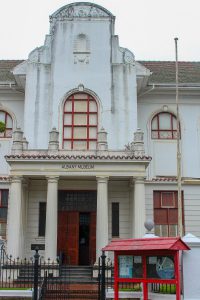By Fahdia Msaka
Makhanda’s Albany Museum, the second oldest museum in South Africa, has long held a significant place in the cultural and historical landscape of the Eastern Cape. It is a provincial museum consisting of a family of seven buildings, each dedicated to preserving South Africa’s history and heritage.
Albany Museum is part-funded by the Eastern Cape Department of Sports Recreation, Arts, and Culture and also generates its own funding. Therefore, the board must approve any expense exceeding R10 000 but the province makes decisions regarding the usage of large external monetary amounts. While the museum has a rich history and a vital role, concerns by employees and board members about its current state and management have been brought forward.
The museum’s board is meant to consist of eight members, appointed according to specific criteria for a maximum of five years. However, the board operates with only five members, following a few members’ resignations and retirement. While a decision was made to co-opt additional members, this has yet to materialise. This reduced board size raises concerns about its ability to oversee the museum’s operations effectively.
Board member and local Makhanda advocate Jock McConnachie expressed his concerns regarding the board’s inability to function correctly with only four members. This situation can impede decision-making and potentially affect the governance of the museum, he said.

One alarming issue that came to light is the burglary at the Observatory Museum, which occurred in June 2021. The burglary was not reported to the museum then, and its extent was only confirmed months later when rumors began circulating. This incident exposed significant flaws in the museum’s security and inventory control.
The perpetrator of the burglary had access to a key, the museum’s alarm code, and security camera footage identified them. However, the museum could not ascertain the full extent of the loss due to inadequate inventory control. An internal investigation by the Eastern Cape Department of Recreation, Arts, and Culture has yet to be finalised.
The failure to promptly report the burglary and the poor record-keeping within the museum is deeply concerning. “Irreplaceable objects were left unlocked and uninsured, and it remains unclear what was stolen and how it was lost,” said McConnachie.
Another problem is that the valuable Frederick I’Ons collection, including the iconic portrait of the warrior-prophet Makana, requires restoration. Regrettably, none of the R400 000 recently allocated by the department has been spent on restoring the paintings. Instead, it has been diverted to upgrading the exhibition space.
The chairperson of the board, Lindile Jela says, “We have taken those issues and sent a report to the Department of Sports Recreation, Arts Culture in the province. They are in the process of addressing those issues.” The board will meet on 31 October, where they have agreed to discuss these concerns and work towards a resolution.
The state of Albany Museum is a matter of public interest, as it plays a crucial role in preserving South Africa’s cultural and historical heritage. It is vital for the board, the museum’s management, and the province to work together to address the current challenges and restore the public’s trust in the institution.
While the museum has a storied history, it must be preserved and managed effectively to continue serving the community and the nation. Albany Museum’s survival and prosperity are contingent on addressing the concerns and taking the necessary steps to ensure its preservation and growth for future generations.


